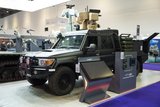BAE Systems unveils new family of networking radios
BAE Systems has launched a new family of networking radios called Phoenix, designed to meet the evolving communications needs of the US military, and fill the gap between higher headquarters and the warfighter.
According to the company, the Phoenix radios deliver secure, jam-resistant communications on the battlefield via modern networking waveforms. The company has responded to the US Army’s request for a non-developmental Mid-tier Networking Vehicular Radio (MNVR) solution with its two-channel Phoenix-SC radio, ‘which meets or exceeds all specifications’.
The Phoenix family are designed to operate the Wideband Networking Waveform (WNW) and the Soldier Radio Waveform (SRW), enabling multiple configurations and providing full anti-jam modes in WNW to protect communications in hostile environments. BAE Systems has leveraged commercial technology to create a low size, weight, and power design that can integrate easily into the existing radio space on US Army ground combat vehicles. To simplify end-user training and adoption, Phoenix radios are fully interoperable with other Joint Tactical Radio Systems currently in use.
Joseph Senftle, vice president and general manager of Communications and Control Solutions at BAE Systems, said: ‘The Phoenix family of radios offers the most complete MNVR solution for battlefield communications. With decades of experience in software-defined radio technology, BAE Systems developed the Phoenix radios with affordability, reduced size, weight, and power, as well as robust anti-jam capabilities, as top priorities.’
More from Digital Battlespace
-
![Babcock nears first customer for Nomad AI translation tool]()
Babcock nears first customer for Nomad AI translation tool
Nomad can provide militaries with real-time intelligence, saving critical time on the battlefield.
-
![AUSA 2025: Israel’s Asio Technologies to supply hundreds of improved Taurus tactical systems]()
AUSA 2025: Israel’s Asio Technologies to supply hundreds of improved Taurus tactical systems
Taurus operates alongside the Israel Defense Forces’ Orion system which supports mission management across tens of thousands of manoeuvring forces, from squad leaders to battalion commanders.
-
![AUSA 2025: Kopin pushes micro-LED plans as China moves faster]()
AUSA 2025: Kopin pushes micro-LED plans as China moves faster
The plan for the new displays follows fresh investment in Kopin’s European facilities by Theon and an order for head-up displays in fielded aircraft, with funding from the US Department of Defense.
-
![AUSA 2025: Persistent Systems to complete its largest order by year’s end]()
AUSA 2025: Persistent Systems to complete its largest order by year’s end
Persistent Systems received its largest ever single order for its MPU5 devices and other systems earlier this month and has already delivered the 50 units to the US Army’s 4th Infantry Division.
-
![Aselsan brings in dozens of companies and systems under the Steel Dome umbrella]()
Aselsan brings in dozens of companies and systems under the Steel Dome umbrella
Turkey has joined the family of countries attempting to establish a multilayered air defence system with government approval in August 2024 for the effort landed by Aselsan. Dubbed Steel Dome, the programme joins Israel’s Iron Dome, the US Golden Dome, India’s Mission Sudarshan Chakra and South Korea’s low-altitude missile defence system.
-
![DSEI 2025: MARSS unveils new agnostic multidomain C4 system]()
DSEI 2025: MARSS unveils new agnostic multidomain C4 system
MARSS’ NiDAR system has been deployed using sensors from static platforms to provide detection and protection for static sights, such as critical infrastructure, ports and military bases.




























